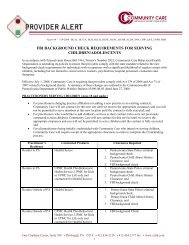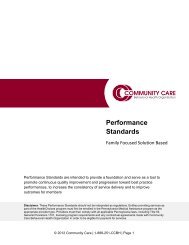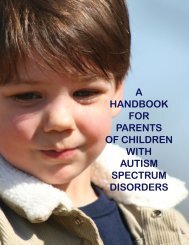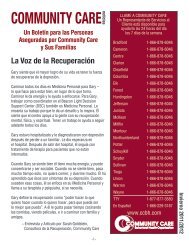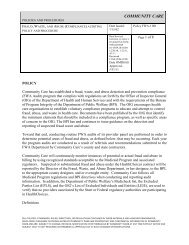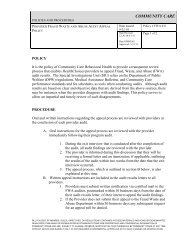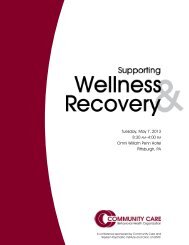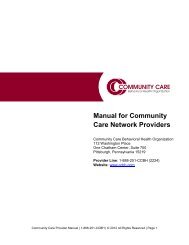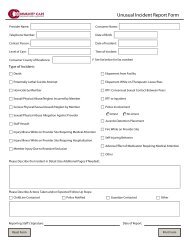Concurrent and Discharge Review - Community Care Behavioral ...
Concurrent and Discharge Review - Community Care Behavioral ...
Concurrent and Discharge Review - Community Care Behavioral ...
You also want an ePaper? Increase the reach of your titles
YUMPU automatically turns print PDFs into web optimized ePapers that Google loves.
POLICIES AND PROCEDURESUtilization Management: <strong>Concurrent</strong><strong>and</strong> <strong>Discharge</strong> <strong>Review</strong>Date Issued:11/1/11Date Revised:12/29/2011COMMUNITY CAREPolicy #CM001Page 1 of 8Date <strong>Review</strong>ed:Date OMH/OASASApproved: 1/2/2012POLICYTo ensure that the goals of the New York State Office of Mental Health (OMH) <strong>and</strong> New York State Officeof Substance Abuse <strong>and</strong> Alcoholism Services (OASAS) are met, <strong>Community</strong> <strong>Care</strong> provides comprehensivecare coordination for children, adults, <strong>and</strong> those with co‐occurring mental health <strong>and</strong> substance usedisorders, as well as those who have concurrent medical conditions <strong>and</strong> are receiving inpatient care.This care coordination focuses on those receiving services in inpatient mental health, inpatientdetoxification, <strong>and</strong> inpatient rehabilitation levels of care. In addition, special focus will be placed onthose who have co‐occurring physical illnesses or disabilities as well as those individuals who areidentified by OMH <strong>and</strong> OASAS as high need individuals who have become disengaged from care. Eachindividual will have a care monitor with training <strong>and</strong> experience consistent with specific needs. It is theresponsibility of the care monitor to promote <strong>and</strong> facilitate the coordination between behavioral healthservice providers, child‐serving systems, primary care physicians, general <strong>and</strong> specialty physical healthproviders <strong>and</strong> health homes, MATS, <strong>and</strong> other community based services including housing, AA, NA, orpeer supports.The New York State Fee‐For‐Service population being reviewed by <strong>Community</strong> <strong>Care</strong> will include:1. All Medicaid fee‐for‐service admissions to OMH‐licensed psychiatric units (all ages) in generalhospitals (Article 28 hospitals)2. Medicaid fee‐for‐service children <strong>and</strong> youth admitted to OMH‐licensed private psychiatrichospitals (Article 31 hospitals)3. Medicaid fee‐for‐service <strong>and</strong> Medicaid Managed <strong>Care</strong> direct admissions, not transfers, toOMH State‐operated children’s psychiatric centers or children’s units of psychiatric centers.4. Medicaid Fee for service OASAS Certified Part 816 Inpatient Detoxification Services (Article28/32)5. Medicaid Fee for service OASAS Certified Hospitals (Article 28/32) or free st<strong>and</strong>ing (Article 32only) Part 818 Chemical Dependence Inpatient Rehabilitation Services*BHOs are not responsible for reviewing 72 Hour Extended Observation Beds forComprehensive Psychiatric Emergency Programs (CPEPs)<strong>Care</strong> coordination begins with the initial contact with acute level providers during the inpatient stay withparticular focus on the goal of comprehensive discharge planning. A thorough assessment of consumerALL POLICIES, STANDARDS, RULES, DIRECTIVES, OR REGULATIONS CONTAINED IN THESE MATERIALS AND HOWEVER DENOMINATED, DEVELOPED, PUBLISHED ORPROMULGATED BY COMMUNITY CARE ARE PROPRIETARY AND CONFIDENTIAL INFORMATION OF COMMUNITY CARE AND ARE SUBJECT TO CHANGE, REVISION,MODIFICATION OR WITHDRAWALS BY COMMUNITY CARE AT ANY TIME WITHOUT NOTICE AND SUBJECT ONLY TO ANY REQUIRED GOVERNMENTAL APPROVALS ASTO SUCH CHANGES OR MODIFICATIONS.
POLICIES AND PROCEDURESUtilization Management: <strong>Concurrent</strong><strong>and</strong> <strong>Discharge</strong> <strong>Review</strong>Date Issued:11/1/11Date Revised:12/29/2011COMMUNITY CAREPolicy #CM001Page 2 of 8Date <strong>Review</strong>ed:Date OMH/OASASApproved: 1/2/2012need is reviewed with the provider, <strong>and</strong> plans to meet those needs are expected to be developedthrough the treatment planning process, culminating in a comprehensive discharge plan.For those consumers who are readmitted to the same level of care, or from one acute level of care toanother within 7 or 30 days, a comprehensive review of the previous discharge planning will also beassessed <strong>and</strong> evaluated with the treatment planning efforts focused on community reengagement.Clinical templates have been designed for care monitor use in the utilization management process inPsychConsult. All OMH/OASAS required data fields have been embedded in PsychConsult for reportingpurposes. In addition, all necessary clinical information required to determine medical necessity hasbeen included. To ease administrative burden on providers <strong>and</strong> to ensure transparency, clinicaltemplates are available on line at ccbh.com.PROCEDURE<strong>Concurrent</strong> <strong>Review</strong>A. Admission Notification – Providers will notify <strong>Community</strong> <strong>Care</strong> of an admission to inpatient mentalhealth, inpatient detoxification or inpatient rehabilitation services for any Medicaid FFS oryouth in Medicaid Managed <strong>Care</strong> a within 24 hours of admission or by 5 p.m. the followingbusiness day of the admission is on a weekend or holiday. Providers may notify <strong>Community</strong> <strong>Care</strong>telephonically 24 hours/day <strong>and</strong> 7 days/week or through a secure web serve site.1. Customer Service staff will log the notification into the PsychConsult database.2. The <strong>Care</strong> Monitor will retrieve the contact in the database.3. The <strong>Care</strong> Monitor will review the service utilization <strong>and</strong> case history, <strong>and</strong> identify if theconsumer has been designated as high need by OMH or OASAS. .4. The <strong>Care</strong> Monitor will complete the initial review with the provider*. The initial reviewswill be completed as follows: Inpatient mental health‐ within 72 hours after notification of admission or by 5P.M. the next business day following notification of the admission by the provider,whichever is later.ALL POLICIES, STANDARDS, RULES, DIRECTIVES, OR REGULATIONS CONTAINED IN THESE MATERIALS AND HOWEVER DENOMINATED, DEVELOPED, PUBLISHED ORPROMULGATED BY COMMUNITY CARE ARE PROPRIETARY AND CONFIDENTIAL INFORMATION OF COMMUNITY CARE AND ARE SUBJECT TO CHANGE, REVISION,MODIFICATION OR WITHDRAWALS BY COMMUNITY CARE AT ANY TIME WITHOUT NOTICE AND SUBJECT ONLY TO ANY REQUIRED GOVERNMENTAL APPROVALS ASTO SUCH CHANGES OR MODIFICATIONS.
POLICIES AND PROCEDURESUtilization Management: <strong>Concurrent</strong><strong>and</strong> <strong>Discharge</strong> <strong>Review</strong>Date Issued:11/1/11Date Revised:12/29/2011COMMUNITY CAREPolicy #CM001Page 3 of 8Date <strong>Review</strong>ed:Date OMH/OASASApproved: 1/2/2012 Inpatient detoxification‐ within 72 hours after notification of admission or by 5P.M. the next business day following notification of the admission by the provider,whichever is later. Inpatient rehabilitation‐ within 72 hours after notification of admission or by 5P.M. the next business day following notification of the admission by the provider,whichever is later.*If discharge is imminent as determined on notification, every effort will be made tocoordinate discharge planning during off hours, week‐ends, <strong>and</strong> holidays through an oncall care monitor.B. Initial <strong>Review</strong> – <strong>Community</strong> <strong>Care</strong> will call the inpatient provider within specified timeframes toconduct a concurrent review, <strong>and</strong> to provide information <strong>and</strong> assistance to the provider. Thecare monitor will:1. <strong>Review</strong> the individual’s recent utilization of behavioral health services from the serviceutilization history.2. <strong>Review</strong> the individual’s recent general health care services utilization history includingsummary of pharmacy claims <strong>and</strong> assessment of medication adherence.3. <strong>Review</strong> the consumer’s participation in a Health Home, ACT, BCM, or presence of anAOT order.4. Identify previous community based provider.5. Identify if a community care coordinator is involved with the consumer.6. Ascertain the presence of family or other supports.7. Assist the provider with the development of an appropriate treatment plan informed byservice utilization history <strong>and</strong> all information obtained by <strong>Community</strong> <strong>Care</strong> through thecourse of assessment <strong>and</strong> monitoring the individual’s treatment.8. Assist the provider in the development of an appropriate discharge <strong>and</strong> disposition planbased on service utilization trends <strong>and</strong> all information obtained by <strong>Community</strong> <strong>Care</strong>through the course of monitoring the individual’s treatment.9. Assess the housing status <strong>and</strong> ensure that housing status is determined upon the initialreview.ALL POLICIES, STANDARDS, RULES, DIRECTIVES, OR REGULATIONS CONTAINED IN THESE MATERIALS AND HOWEVER DENOMINATED, DEVELOPED, PUBLISHED ORPROMULGATED BY COMMUNITY CARE ARE PROPRIETARY AND CONFIDENTIAL INFORMATION OF COMMUNITY CARE AND ARE SUBJECT TO CHANGE, REVISION,MODIFICATION OR WITHDRAWALS BY COMMUNITY CARE AT ANY TIME WITHOUT NOTICE AND SUBJECT ONLY TO ANY REQUIRED GOVERNMENTAL APPROVALS ASTO SUCH CHANGES OR MODIFICATIONS.
POLICIES AND PROCEDURESUtilization Management: <strong>Concurrent</strong><strong>and</strong> <strong>Discharge</strong> <strong>Review</strong>Date Issued:11/1/11Date Revised:12/29/2011COMMUNITY CAREPolicy #CM001Page 4 of 8Date <strong>Review</strong>ed:Date OMH/OASASApproved: 1/2/201210. Assess provider’s plan to contact the care coordinator, outpatient provider, or healthhome during the inpatient stay. Prompt the provider to ensure completion of contact.11. Assess dangerousness, mental status review, functional status, presence of a cooccurringdisorder, substance use/abuse, <strong>and</strong> diagnoses on 5 axes.12. Determination of medical necessity. For inpatient mental health for children <strong>and</strong> adults,The Mihalek Acute Inpatient MNC 1 will be used. For detoxification <strong>and</strong> rehabilitation,ASAM criteria IV <strong>and</strong> IV D 2 will be used. These criteria are embedded in the clinicalreview template.13. A shadow authorization will be added to the template <strong>and</strong> will be invisible to theprovider. This is for internal use <strong>and</strong> use by OMH/OASAS only. This will assist indetermining length of stay <strong>and</strong> valid admission <strong>and</strong> discharge dates. The day ofadmission will be counted; the day of discharge will not be counted in the number ofdays that are authorized.C. Subsequent reviews are those that will occur after the <strong>Care</strong> Monitor review of service utilizationhistory <strong>and</strong> preliminary discharge plan formulation. Subsequent reviews will occur at thefollowing intervals:1. No more than five days for inpatient mental health reviews2. Not more than two days for inpatient detoxification reviews3. No more than seven days for inpatient rehabilitationIn the event that a consumer is in a facility <strong>and</strong> it is clinically determined that this may bea long stay due to clinical presentation, this consumer will be identified in PsychConsultthrough a specific dropdown field where a report may be developed to identify thesespecific consumers. The provider <strong>and</strong> care monitor will determine the appropriate timeintervals for reviews. In all cases, the care monitor will continue to prompt for adequatedischarge planning <strong>and</strong> will continue to review at reasonable intervals.1 The Mihalik Group (TMG) Amended Inpatient Mental Health Criteria for Children <strong>and</strong> Adults2 Mee‐Lee D, Shulman GD, Fishman M, Gastfriend DR, <strong>and</strong> Griffith JH, eds. (2001) ASAM Patient Placement Criteria for theTreatment of Substance‐Related Disorders – Second Edition ‐ Revised (ASAM.PPC‐ 2R). Chevy Chase, MD: American Society ofAddiction Medicine, Inc.ALL POLICIES, STANDARDS, RULES, DIRECTIVES, OR REGULATIONS CONTAINED IN THESE MATERIALS AND HOWEVER DENOMINATED, DEVELOPED, PUBLISHED ORPROMULGATED BY COMMUNITY CARE ARE PROPRIETARY AND CONFIDENTIAL INFORMATION OF COMMUNITY CARE AND ARE SUBJECT TO CHANGE, REVISION,MODIFICATION OR WITHDRAWALS BY COMMUNITY CARE AT ANY TIME WITHOUT NOTICE AND SUBJECT ONLY TO ANY REQUIRED GOVERNMENTAL APPROVALS ASTO SUCH CHANGES OR MODIFICATIONS.
POLICIES AND PROCEDURESUtilization Management: <strong>Concurrent</strong><strong>and</strong> <strong>Discharge</strong> <strong>Review</strong>Date Issued:11/1/11Date Revised:12/29/2011COMMUNITY CAREPolicy #CM001Page 5 of 8Date <strong>Review</strong>ed:Date OMH/OASASApproved: 1/2/2012Subsequent reviews will be used to update clinical information, ensure adequatetreatment planning, identify contact of community behavioral health <strong>and</strong> other healthproviders, including SUD <strong>and</strong> housing, determine referral needs, ensure collaboration ofchild serving systems, identify service planning meeting opportunities, determinefamily/other support for the consumer, identify realistic <strong>and</strong> involved discharge planningfollow up opportunities, <strong>and</strong> determine current medical necessity. If medical necessitycriteria are not met, see Policy #CM002. Although medical necessity will continue to bedetermined on long stay reviews, no notice of preliminary findings will be issued, <strong>and</strong>reviews will be continued throughout the discharge planning process.D. During all reviews, the <strong>Care</strong> Monitor will prompt the inpatient service providers to identifyindividuals in inpatient treatment with a chronic <strong>and</strong>/or serious physical health diagnoses <strong>and</strong>monitor whether the person’s behavioral health <strong>and</strong> non‐behavioral health medical services areconsidered <strong>and</strong> coordinated.1. Diagnoses2. Physical health complications <strong>and</strong> impact on mental status3. History of non adherence to treatment4. Medication changes, regime <strong>and</strong> compliance history5. Follow up appointments6. Pregnancy7. Identification of high need or the presence of a serious mental illnessE. <strong>Community</strong> <strong>Care</strong> will prompt <strong>and</strong> facilitate the inpatient provider’s direct communication withother treating providers or community supports during a consumer’s inpatient stay. Theseinclude, but are not limited to:1. Primary <strong>Care</strong> Physician2. Physical Health Plan3. Special Needs Plan4. Health Home5. <strong>Community</strong> based mental health or drug <strong>and</strong> alcohol services6. Education7. Juvenile justiceALL POLICIES, STANDARDS, RULES, DIRECTIVES, OR REGULATIONS CONTAINED IN THESE MATERIALS AND HOWEVER DENOMINATED, DEVELOPED, PUBLISHED ORPROMULGATED BY COMMUNITY CARE ARE PROPRIETARY AND CONFIDENTIAL INFORMATION OF COMMUNITY CARE AND ARE SUBJECT TO CHANGE, REVISION,MODIFICATION OR WITHDRAWALS BY COMMUNITY CARE AT ANY TIME WITHOUT NOTICE AND SUBJECT ONLY TO ANY REQUIRED GOVERNMENTAL APPROVALS ASTO SUCH CHANGES OR MODIFICATIONS.
POLICIES AND PROCEDURESUtilization Management: <strong>Concurrent</strong><strong>and</strong> <strong>Discharge</strong> <strong>Review</strong>Date Issued:11/1/11Date Revised:12/29/2011COMMUNITY CAREPolicy #CM001Page 6 of 8Date <strong>Review</strong>ed:Date OMH/OASASApproved: 1/2/20128. Protective services9. MATS10. AOT monitoring11. ACT/ICM/BCM12. SPOAReadmission <strong>Review</strong>A. For those consumers identified as a readmission (when the information is available) within 7 or30 days to an acute level of care, inpatient mental health or inpatient detoxification, a specificreview will be completed of the previous discharge planning effectiveness. A step‐down to arehabilitation level of care will not be considered as a readmission. This assessment iscompleted on all known readmissions. Contributory factors will be identified including:1. Consumer involvement in the d/c planning process2. Involvement of the family/support system3. Consumer preferences4. Consumer treatment expectations5. Consumer education6. Provider knowledge of discharge options <strong>and</strong> feasibility of those options7. Active referrals8. Notification of community based providers during previous inpatient stay9. Notification of community based providers upon discharge from previous inpatient stay10. Previous inpatient provider written communication with the community based provider11. Attention to the multi‐system needs of youth from previous admission12. Appropriate referrals from previous inpatient providerB. During concurrent review with a provider on those who have been readmitted, alternativecommunity based treatment options will be considered. The care monitor will offer potentialinterventions to enhance engagement opportunities. A professional advisor will be consulted on2 readmissions to a detoxification or inpatient mental health level of care within 3 months.<strong>Discharge</strong> <strong>Review</strong>ALL POLICIES, STANDARDS, RULES, DIRECTIVES, OR REGULATIONS CONTAINED IN THESE MATERIALS AND HOWEVER DENOMINATED, DEVELOPED, PUBLISHED ORPROMULGATED BY COMMUNITY CARE ARE PROPRIETARY AND CONFIDENTIAL INFORMATION OF COMMUNITY CARE AND ARE SUBJECT TO CHANGE, REVISION,MODIFICATION OR WITHDRAWALS BY COMMUNITY CARE AT ANY TIME WITHOUT NOTICE AND SUBJECT ONLY TO ANY REQUIRED GOVERNMENTAL APPROVALS ASTO SUCH CHANGES OR MODIFICATIONS.
POLICIES AND PROCEDURESUtilization Management: <strong>Concurrent</strong><strong>and</strong> <strong>Discharge</strong> <strong>Review</strong>Date Issued:11/1/11Date Revised:12/29/2011COMMUNITY CAREPolicy #CM001Page 7 of 8Date <strong>Review</strong>ed:Date OMH/OASASApproved: 1/2/2012A. The <strong>Care</strong> Monitor will work with the inpatient providers to identify barriers that couldpotentially interrupt or prevent a high need individual from either arriving at their scheduledbehavioral or physical health follow up appointments or following through with the prescribedtreatment or recommendations. Potential barriers will be determined by reviewing thefollowing elements of a successful transition <strong>and</strong> solutions will be developed to ensureengagement success.1. Was the individual involved <strong>and</strong> invested in the aftercare plan for their behavioralhealth <strong>and</strong> physical health needs?2. Is the individual’s family or support system available to be involved in planning <strong>and</strong>execution?3. Is the person able to determine a method <strong>and</strong> financial means for transportation tobehavioral <strong>and</strong> physical health follow up appointments?4. Does the individual have special needs in terms of housing, language, hearing, sight,cognition or mobility that would keep them from keeping appointments or followingthrough on recommendations?5. Does the individual have <strong>and</strong> know the name <strong>and</strong> phone number of their behavioralhealth <strong>and</strong> primary care physician, Health Home or local clinic?B. All referrals will be documented in PsychConsult including the type of provider, the name of theprovider <strong>and</strong> the appointment date. The care monitor will:1. Determine if a physical health referral, a mental health referral, a drug <strong>and</strong> alcohol referralor a housing referral was indicated.2. Assess housing status upon discharge.3. Determine if an AOT petition was filed.4. Determine a child’s needs in terms of education, family involvement, juvenile justiceinvolvement, or dependency.5. Determine if a SPOA application is pending for services or housing.6. Identify the presence of a crisis plan.7. Ensure that the inpatient provider agrees to send the discharge plan <strong>and</strong> summary oftreatment to the receiving community provider.8. Address barriers that may interfere with the consumer’s recovery.ALL POLICIES, STANDARDS, RULES, DIRECTIVES, OR REGULATIONS CONTAINED IN THESE MATERIALS AND HOWEVER DENOMINATED, DEVELOPED, PUBLISHED ORPROMULGATED BY COMMUNITY CARE ARE PROPRIETARY AND CONFIDENTIAL INFORMATION OF COMMUNITY CARE AND ARE SUBJECT TO CHANGE, REVISION,MODIFICATION OR WITHDRAWALS BY COMMUNITY CARE AT ANY TIME WITHOUT NOTICE AND SUBJECT ONLY TO ANY REQUIRED GOVERNMENTAL APPROVALS ASTO SUCH CHANGES OR MODIFICATIONS.
POLICIES AND PROCEDURESUtilization Management: <strong>Concurrent</strong><strong>and</strong> <strong>Discharge</strong> <strong>Review</strong>Date Issued:11/1/11Date Revised:12/29/2011COMMUNITY CAREPolicy #CM001Page 8 of 8Date <strong>Review</strong>ed:Date OMH/OASASApproved: 1/2/2012All reasonable efforts will be expected by inpatient facilities to ensure adequate dischargeplanning, including those efforts with individuals who may be discharged AMA or in the eventof an elopement. Every effort will be made with both the inpatient provider <strong>and</strong> thecommunity based provider to engage those individuals.ALL POLICIES, STANDARDS, RULES, DIRECTIVES, OR REGULATIONS CONTAINED IN THESE MATERIALS AND HOWEVER DENOMINATED, DEVELOPED, PUBLISHED ORPROMULGATED BY COMMUNITY CARE ARE PROPRIETARY AND CONFIDENTIAL INFORMATION OF COMMUNITY CARE AND ARE SUBJECT TO CHANGE, REVISION,MODIFICATION OR WITHDRAWALS BY COMMUNITY CARE AT ANY TIME WITHOUT NOTICE AND SUBJECT ONLY TO ANY REQUIRED GOVERNMENTAL APPROVALS ASTO SUCH CHANGES OR MODIFICATIONS.



